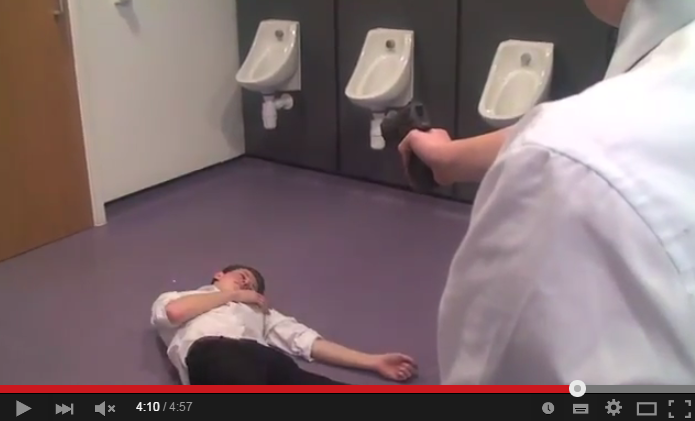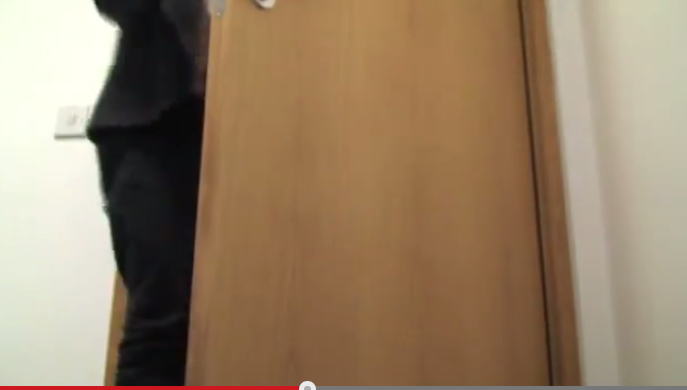Evaluation
Question 1 - In what
ways does the media product use, develop or challenge forms and conventions of
real media products?
For our advanced portfolio we were set the task of creating
our own media product. We were challenged with creating a short feature film,
consisting of a start, middle, and end with a title sequence and end credits.
This was similar to our foundation portfolio production of creating a two
minute opening to a film.
Rules
There are three main rules that we needed to follow as is
required with film production. These are the 180 degree rule, shot reverse shot
and match on action. These rules need to be followed in order to give the film
a continuous flow and aid the chronology of the film. As well as giving the
film a real and believable feel.
The 180-degree rule
is a basic guideline regarding the on-screen spatial relationship between a
character and another character or object within a scene. An imaginary line
called the axis connects the characters, and by keeping the camera on one side
of this axis for every shot in the scene, the first character is always frame
right of the second character, who is then always frame left of the first. The
camera passing over the axis is called crossing the line, and this must be
avoided at all times if possible.
The object that is being filmed must always remain in the centre,
while the camera must always face towards the object.
Shot Reverse Shot is a technique that includes shots that
views the action from the opposite side of the previous shot usually over the
shoulder of each actor. This can be used during dialogue between two
characters, giving the effect of a flowing conversation.
Match on action is a filming and video editing technique whereby
an editor cuts from one shot to another that matches the first shots action,
although the shots may have actually been filmed hours apart. For example an
actor opening a door from the outside cuts to the actor walking through the
door.
In order to complete our film to a good standard we need to
stick to these rules at all times to improve the continuity of our film. So in
this sense we are using the generic conventions of real media products.
-Weapons

The idea of film we decide to produce was based on a man who
was out to get revenge against a hitman who killed his best friend and business
partner. We came to the conclusion that our film would be an action thriller. In
order to accurately represent a film from that genre I thoroughly conducted
some in-depth genre research.
As the action thriller genre is a hybrid genre I researched
each genre separately and found that thriller films build suspense. So in order
to meet this we added a part to the storyline where two characters have a standoff
resulting in one character being shot, but it isn't clear at first who has
shot. This builds suspense, also the killer’s identity is unknown for most of
the film so the audience will be left guessing who has shot the gun.
I also discovered that an action film is described as a film
that features a series of situations involving physical altercations. These
types of film are often categorised by the presence of guns, fight scenes and
explosions. A typical example of one of these types of film would be Die Hard.
So in order to follow these conventions we decided that our
film would need to feature confrontation, such as fight scenes and guns. We
added a fight scene where two characters fight in a bathroom until one of the
characters is killed. We identified death as an important part of these films
too, so after we use the gun to shoot the hitman character in the knee, we
decided that in a professional film of this genre we would probably see the
character die. So for that reason we added the hitman's death at the end. This
is yet another example of us using generic conventions as seen in real media
products.
We wanted the film that we created to be a classic action
thriller film. A homage to other action thriller films. However we did add
somethings that you would not expect to see in this type of film. I feel that
in a part of our film we had an element of pastiche or parody. When the hitman
enters his car he puts on the radio. We decided to create and record a fake
radio show to play while the hitman was driving. This featured upbeat funky
music that doesn't really have any place in a film of this genre. This music is
the repeated at the end over the credits where you would expect a much slower
droned out sound to continue the intensity of the film right to the very end.
Also on the radio show there is a presenter speaking who whilst speaking says a
phrase that we intended to be a pun to foreshadow the end of the film. The
presenter says 'this song is for those of you who would kill to get out of work
right now', this could trigger some of the audience to think that there will be
a death at some point at the end of the film. These examples show that we have
challenged the conventions of this genre, as well as us possibly developing the
conventions of this genre by adding our own twist to them.
The main conventions that feature in this genre of film are
as follows:
-Weapons
-Death
-Blood
-Confrontation/Violence
-Suits
We included all of these in our own film so that we could
show our intent to follow the conventions of our genre of film and here are some examples:

There have been many influences for our film, some of them
being real media texts one example is that we needed a different type of shot
for the scene where the Hitman is confronted and shot by Quincey, then I came
across a shot used in the TV show Breaking Bad, where the character Jesse
Pinkman is shot in a 360 degree motion but is cut in the middle to add effect
to an around shot to increase the intensity and suspense of the shot.
Another influence on our film was the film Sahara. This is
slightly different to our genre film. Sahara is an action comedy, however we were able to take its title sequence as inspiration for our own title sequence.The title
sequence for Sahara features one long pan shot which moves around a room full
of objects and pictures which allows you to infer key details about the film.
We did a similar thing in our title sequence by having one long shot around an
office desk that had all of the key objects from our film on it, such as a gun, office equipment, car keys and a computer.
Audience Pleasure and Richard Dyers Utopian solution theory
Richard Dyer, a film theorist, argues that one of the functions of entertainment is to give the audience a Utopian environment.
Reality: Exhaustion, scarcity, dreariness, manipulation, fragmentation
But Dyer said that entertainment such as films should provide the following to give the audience the best experience possible.
Utopian Solution: Energy, abundance, intensity, transparency, community
In our film we tried to incorporate as many of these as we possibly could, within our time limit, budget and genre restraints.
 Energy: In our film we have a lot of energy as a result of our action scenes, such as the confrontation/fight scenes and the chase leading up to that. This is helped by the fast paced editing and the underlying soundtrack that we gave these scenes.
Energy: In our film we have a lot of energy as a result of our action scenes, such as the confrontation/fight scenes and the chase leading up to that. This is helped by the fast paced editing and the underlying soundtrack that we gave these scenes.Abundance: In the time previous to our film being set, when Carlos had not yet being killed, Quincey would have had a great deal. Family, best friend, business, but during the time of the setting of our film, when Carlos is dead, Quincey has nothing, causing him to want to seek revenge during our film.

Intensity: There is a strong balance of this in our production, high intensity when the character Quincey gets his revenge and low intensity when the Hitman is pursuing Quincey only to find that he is actually the one who is being hunted and confronted.
Community: This has quite a strong link with abundance in our case, as when the Hitmans actions result in Quincey losing everything, Quincey was trapped and began to become depressed as a result.
 Transparency: As we didn't have much time available in our film for character development, with our limit of 5 minutes, we used voice overs in order to describe the character and the position they are in quickly and effectively. This shows honesty and a more obtuse aspect of the characters and the film overall.
Transparency: As we didn't have much time available in our film for character development, with our limit of 5 minutes, we used voice overs in order to describe the character and the position they are in quickly and effectively. This shows honesty and a more obtuse aspect of the characters and the film overall.I think we were successful in creating a product that gave pleasure to the audience and this was backed up by the audience feedback in terms of enjoyment.










No comments:
Post a Comment